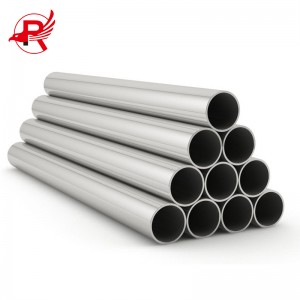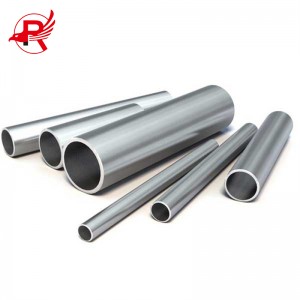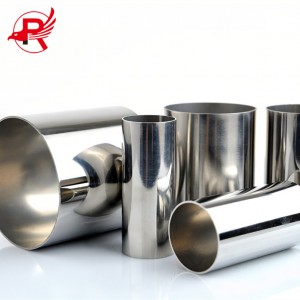I-Royal Group 316 316l Eshiselwe Ipayipi Lensimbi Engagqwali lasePoland
Ipayipi lensimbi engagqwali ipayipi eliyisilinda elenziwe ngensimbi engagqwali, insimbi engagqwali engagqwali equkethe okungenani i-chromium engu-10.5%. Lawa mashubhu asetshenziswa ezinhlobonhlobo zezicelo ezihlanganisa ukwakhiwa, izingxenye zezimoto, amapayipi, kanye nemishini yezimboni. Nansi eminye imininingwane ngamapayipi ensimbi engagqwali:
1. Usayizi: Amashubhu ensimbi engagqwali atholakala ngobukhulu obuhlukahlukene, kusukela kushubhu owububanzi obuncane bemishini yezokwelapha ukuya kumashubhu amakhulu obubanzi bokwakha.
2. Ibanga: Kunamabanga ahlukene wepayipi lensimbi engagqwali, njenge-304 noma 316, elizothinta ukwakheka nokusebenza kwalo kwamakhemikhali.
3. Ukuma: Ukuma kwethubhu yensimbi engagqwali kungaba yindilinga, isikwele noma unxande, kuye ngokuthi isicelo.
4. Ukuqina kwezindonga: Ubukhulu bodonga lwepayipi yensimbi engagqwali bungahluka kuye ngobukhulu balo kanye nokusetshenziswa okuhlosiwe. Izindonga eziwugqinsi zisetshenziselwa izicelo zokucindezela okukhulu, kuyilapho izindonga ezincanyana zisetshenziselwa izicelo zokucindezela okuphansi.
5. Ukuqeda: Amashubhu ensimbi engagqwali angaqedwa ngokupholisha, ukuthungatha, ukucosha kanye nezinye izindlela ukuze kuzuzwe indawo ekahle yokuqeda kanye nokumelana nokugqwala.
6. Ukushisela: Amapayipi ensimbi engagqwali angashiswa ngezindlela ezahlukene, okuhlanganisa ukushisela kwe-TIG, ukushisela kwe-MIG kanye ne-laser welding.
7. Amazinga: Amapayipi ensimbi engagqwali kufanele ahlangabezane namazinga athile, njenge-ASTM noma i-EN, ukuqinisekisa ikhwalithi yawo nokufaneleka kwezicelo ezithile.
| Igama Lomkhiqizo | Ipayipi elishiselwe insimbi engagqwali |
| Okujwayelekile | AISI ASTM DIN, EN, GB, JIS |
| Ibanga Lensimbi | 200 Series: 201,202 300 Series: 301,304,304L,316,316L,316Ti,317L,321,309s,310s 400 Series: 409L,410,410s,420j1,420j2,430,444,441,436 I-Duplex Steel: 904L, 2205,2507,2101,2520,2304 |
| Ububanzi bangaphandle | 6-2500mm(njengoba kudingeka) |
| Ubukhulu | 0.3mm-150mm (njengoba kudingeka) |
| Ubude | 2000mm/2500mm/3000mm/6000mm/12000mm(njengoba kudingeka) |
| Icebo | Ingenamthungo |
| Ubuso | No.1 No.4 HL 2B BA 6K 8K Isibuko |
| Ukubekezelelana | ±1% |
| Imigomo Yentengo | FOB,CFR,CIF |
| Ama-invoyisi | ngesisindo sangempela |
| Isampula | Isampula Ngokukhululekile |










Amapayipi ensimbi engagqwali asetshenziswa kakhulu ku-petroleum, imboni yamakhemikhali, imithi, ukudla, ukukhiqizwa kwemishini kanye neminye imikhakha. Ukumelana nokugqwala nokuqina kwayo kuyenza ibe yimpahla yepayipi ekahle yokuthutha uketshezi, amagesi kanye nezinto eziqinile. Izinzuzo zamapayipi ensimbi engagqwali zihlanganisa ukumelana nokugqwala, ukumelana nokushisa okuphezulu, amandla aphezulu, ukuhlanza okulula, nokubukeka okuhle. Lokhu kwenza amapayipi ensimbi engagqwali asetshenziswe kabanzi emikhakheni eminingi, ikakhulukazi ezimweni lapho ukuhlanzeka nokugqwala kuyadingeka.
Qaphela:
1.Isampula yamahhala, isiqinisekiso sekhwalithi sangemuva kokuthengisa esingu-100%, Sekela noma iyiphi indlela yokukhokha;
2.Zonke ezinye izicaciso zamapayipi ensimbi ye-carbon ayindilinga ayatholakala ngokuya ngesidingo sakho (OEM & ODM)! Intengo yefekthri uzoyithola kwa-ROYAL GROUP.
I-Stainless Steel Pipe Chemical Compositions
| Ukwakheka Kwekhemikhali % | ||||||||
| Ibanga | C | Si | Mn | P | S | Ni | Cr | Mo |
| 201 | ≤0 .15 | ≤0 .75 | 5. 5-7. 5 | ≤0.06 | ≤ 0.03 | 3.5 -5.5 | 16 .0 -18.0 | - |
| 202 | ≤0 .15 | ≤l.0 | 7.5-10.0 | ≤0.06 | ≤ 0.03 | 4.0-6.0 | 17.0-19.0 | - |
| 301 | ≤0 .15 | ≤l.0 | ≤2.0 | ≤0.045 | ≤ 0.03 | 6.0-8.0 | 16.0-18.0 | - |
| 302 | ≤0 .15 | ≤1.0 | ≤2.0 | ≤0.035 | ≤ 0.03 | 8.0-10.0 | 17.0-19.0 | - |
| 304 | ≤0 .0.08 | ≤1.0 | ≤2.0 | ≤0.045 | ≤ 0.03 | 8.0-10.5 | 18.0-20.0 | - |
| 304L | ≤0.03 | ≤1.0 | ≤2.0 | ≤0.035 | ≤ 0.03 | 9.0-13.0 | 18.0-20.0 | - |
| 309S | ≤0.08 | ≤1.0 | ≤2.0 | ≤0.045 | ≤ 0.03 | 12.0-15.0 | 22.0-24.0 | - |
| 310S | ≤0.08 | ≤1.5 | ≤2.0 | ≤0.035 | ≤ 0.03 | 19.0-22.0 | 24.0-26.0 | |
| 316 | ≤0.08 | ≤1.0 | ≤2.0 | ≤0.045 | ≤ 0.03 | 10.0-14.0 | 16.0-18.0 | 2.0-3.0 |
| 316L | ≤0 .03 | ≤1.0 | ≤2.0 | ≤0.045 | ≤ 0.03 | 12.0 - 15.0 | 16 .0 -1 8.0 | 2.0 -3.0 |
| 321 | ≤ 0 .08 | ≤1.0 | ≤2.0 | ≤0.035 | ≤ 0.03 | 9.0 - 13 .0 | 17.0 -1 9.0 | - |
| 630 | ≤ 0 .07 | ≤1.0 | ≤1.0 | ≤0.035 | ≤ 0.03 | 3.0-5.0 | 15.5-17.5 | - |
| 631 | ≤0.09 | ≤1.0 | ≤1.0 | ≤0.030 | ≤0.035 | 6.50-7.75 | 16.0-18.0 | - |
| 904L | ≤ 2 .0 | ≤0.045 | ≤1.0 | ≤0.035 | - | 23.0·28.0 | 19.0-23.0 | 4.0-5.0 |
| 2205 | ≤0.03 | ≤1.0 | ≤2.0 | ≤0.030 | ≤0.02 | 4.5-6.5 | 22.0-23.0 | 3.0-3.5 |
| 2507 | ≤0.03 | ≤0.8 | ≤1.2 | ≤0.035 | ≤0.02 | 6.0-8.0 | 24.0-26.0 | 3.0-5.0 |
| 2520 | ≤0.08 | ≤1.5 | ≤2.0 | ≤0.045 | ≤ 0.03 | 0.19 -0. 22 | 0. 24 -0 . 26 | - |
| 410 | ≤0.15 | ≤1.0 | ≤1.0 | ≤0.035 | ≤ 0.03 | - | 11.5-13.5 | - |
| 430 | ≤0.1 2 | ≤0.75 | ≤1.0 | ≤ 0.040 | ≤ 0.03 | ≤0.60 | 16.0 -18.0 | |
Ngezindlela ezihlukene zokucubungula zokuginqika okubandayo kanye nokucutshungulwa kabusha kwendawo ngemva kokugingqika, indawo engaphezulu yensimbi engagqwaliibhas ingaba nezinhlobo ezahlukene.

Ukucubungula okungaphezulu kwepayipi lensimbi engagqwali kune-NO.1, 2B, No. 4, HL, No. 6, No. 8, BA, TR hard, Rerolled bright 2H, polishing bright and other surface finishes, njll.
NO.1: Ingaphezulu lensimbi engagqwali NO.1 icutshungulwa inqubo yokuginqika eshisayo futhi inezici zangaphezulu ezimaholoholo. Phakathi nenqubo yokukhiqiza, i-stainless steel slab iyashisisa futhi igoqwe ngomshini wokugaya oshisayo ukuze kwakheke indawo eqinile. Le ndlela yokwelapha engaphezulu ifanele ezinye izinhlelo zokusebenza ezingenazo izidingo eziphakeme, njengemishini yezimboni, izinto zokwakha, njll. Izakhiwo zayo zihlanganisa indawo emagebhugebhu kanye nokumelana nokugqwala okuhle. Ukusetshenziswa okuyinhloko kufaka phakathi ukwenza imishini yezimboni, izakhiwo zokwakha, izinto zasekhishini, njll.
I-2B: Ubuso be-2B buhlukile ku-2D ngoba bushelelezi nge-roller ebushelelezi, ngakho-ke ikhanya ngaphezu kwe-2D. Ubushelelezi obungaphezulu inani lika-Ra elilinganiswa ithuluzi lingu-0.1~0.5μm, okuwuhlobo lokucubungula oluvame kakhulu. Lolu hlobo lwe-stainless steel strip surface luyizinto ezihlukahlukene kakhulu, ezifanele izinhloso ezijwayelekile, ezisetshenziswa kakhulu embonini yamakhemikhali, iphepha, i-petroleum, yezokwelapha nezinye, futhi ingasetshenziswa njengodonga lwamakhethini wokwakha.
I-TR Hard Finish: I-TR insimbi engagqwali ibizwa nangokuthi insimbi eqinile. Amamaki ayo ensimbi amele angama-304 no-301, asetshenziselwa imikhiqizo edinga amandla aphezulu nobulukhuni, njengezimoto zesitimela, amabhande okuthutha, iziphethu kanye nama-gaskets. Umgomo uwukusebenzisa izici eziqinisa umsebenzi zensimbi engagqwali ye-austenitic ukwandisa amandla nobulukhuni bepuleti lensimbi ngezindlela ezibandayo zokusebenza njengokugingqa. Izinto eziqinile zisebenzisa amaphesenti ambalwa kuya kumashumi ambalwa wamaphesenti wokugoqeka okuncane ukuze kungene indawo yokucaba okuthambile kwendawo eyisisekelo engu-2B, futhi akukho ukushunqiswa okwenziwa ngemva kokugingqika. Ngakho-ke, indawo eqinile ye-TR yento eqinile iyindawo egoqekayo ngemuva kokubanda.
I-Rerolled Bright 2H: Ngemva kwenqubo yokugoqa. ipayipi yensimbi engagqwali izocutshungulwa annealing ekhanyayo. Ipayipi lingapholiswa ngokushesha ngomugqa wokudonsa oqhubekayo. Ijubane lokuhamba lepayipi lensimbi engagqwali kulayini licishe libe ngu-60m~80m/min. Ngemuva kwalesi sinyathelo, ukuqedwa okungaphezulu kuzoba ngu-2H okuphinde kwagoqeka ngokugqama.
No.4: Ubuso beNombolo 4 buwukuphela kwendawo epholile ecwebezelayo ekhanya kakhulu kunobuso beNombolo 3. Ibuye itholakale ngokupholisha ipayipi lensimbi engenasici eligoqelwe ngensimbi engagqwali engu-2 D noma engu-2 B njengesisekelo nokupholishwa ngebhande elihuqayo elinosayizi wokusanhlamvu we-150-180 # Indawo eyenziwe ngomshini. Ubushelelezi obungaphezulu Inani le-Ra elilinganiswa ithuluzi ngu-0.2~1.5μm. I-NO.4 surface isetshenziswa kakhulu endaweni yokudlela nekhishi, imishini yezokwelapha, umhlobiso wezakhiwo, iziqukathi, njll.
HL: I-HL surface ijwayele ukubizwa ngokuthi i-hairline finish. Izinga le-JIS lesi-Japanese libeka ukuthi ibhande elihuqayo elingu-150-240# lisetshenziselwa ukupholisha indawo eqhumayo efana nezinwele etholakalayo. Ngokwezinga laseChina le-GB3280, imithethonqubo ayicacile. I-HL surface finish isetshenziswa kakhulu ekwakheni umhlobiso njengamakheshi, izitebhisi ezizihambelayo, nama-facade.
No.6: Ubuso beNombolo 6 busekelwe ebusweni beNombolo 4 futhi buphinde bupholishwe ngebhulashi le-Tampico noma into e-abrasive enosayizi wezinhlayiyana we-W63 ocaciswe yi-GB2477 ejwayelekile. Le ndawo inokukhanya okuhle kwe-metallic nokusebenza okuthambile. Ukubonakaliswa kubuthakathaka futhi akubonisi isithombe. Ngenxa yalesi sakhiwo esihle, ifaneleka kakhulu ekwenzeni izindonga zamakhethini zokwakha kanye nokwakha imihlobiso ye-fringe, futhi ibuye isetshenziswe kabanzi njengezitsha zasekhishini.
I-BA: I-BA iyindawo etholwe ngokwelashwa okushisa okukhanyayo ngemva kokugoqa okubandayo. Ukwelashwa kokushisa okukhanyayo kungena ngaphansi komkhathi ovikelayo oqinisekisa ukuthi indawo engaphezulu ayinawo oksijini ukuze kulondolozwe ukucwebezela kwendawo egoqelwe ngokubanda, bese kusetshenziswa iroli yokushelela enembayo ephezulu ukuze kumiswe ukukhanya ukuze kuthuthukiswe ukukhanya okungaphezulu. Le ndawo engaphezulu iseduze nesibuko, futhi ubulukhuni obungaphezulu inani lika-Ra elilinganiswa ithuluzi lingu-0.05-0.1μm. I-BA surface inezinto eziningi ezisetshenziswayo futhi ingasetshenziswa njengezitsha zasekhishini, izinto zasendlini, izinto zokwelashwa, izingxenye zezimoto kanye nemihlobiso.
I-No.8: I-No.8 iyindawo eqediwe ngesibuko enokubonakala okuphezulu kakhulu ngaphandle kwezinhlamvu ezilumayo. Imboni yokucubungula ejulile yensimbi engenasici nayo ibiza njengamapuleti angu-8K. Ngokuvamile, izinto ze-BA zisetshenziswa njengezinto ezingavuthiwe zokuqeda isibuko kuphela ngokugaya nokupholisha. Ngemuva kokuqedwa kwesibuko, indawo engaphezulu inobuciko, ngakho-ke isetshenziswa kakhulu ekwakheni umhlobiso wokungena kanye nokuhlobisa kwangaphakathi.
Inqubo yokukhiqiza eyinhloko: insimbi eyindilinga → ukuhlola kabusha → ukucwecwa → ukuvala → ukuvala → ukugxilisa → ukufudumeza → ukubhoboza → ukucosha → ikhanda eliyisicaba → ukuhlola nokugaya → ukugoqa okubandayo (umdwebo obandayo) → ukwehlisa → ukwelapha ukushisa → ukuqondisa → ukusika ipayipi (ubude obulungisiwe ukuya kobude) →ukuhlola →umkhiqizo oqediwe, umshini wokudlula ingcindezi)→ukupakisha nokugcina.
1. Ukusika insimbi eyindilinga: Ngemva kokuthola insimbi eyindilinga kusuka endaweni yokugcina impahla eluhlaza, bala ubude bokusika bensimbi eyindilinga ngokuya ngezidingo zenqubo, bese udweba umugqa ensimbi eyindilinga. Izinsimbi zipakishwa ngokwamabanga ensimbi, izinombolo zokushisa, izinombolo zeqoqo lokukhiqiza kanye nokucaciswa, futhi iziphetho zihlukaniswa ngopende bemibala ehlukene.
2. Ukubeka phakathi nendawo: Uma ubeka maphakathi umshini wokumba wengalo ephambanayo, qala ngokuthola indawo emaphakathi engxenyeni yensimbi eyindilinga, ubhoboze imbobo yesampula, bese uyilungisa iqonde kuthebula lomshini wokumba ukuze ubeke maphakathi nendawo. Amabha ayindilinga ngemva kokubekwa phakathi apakishwe ngokwezinga lensimbi, inombolo yokushisa, ukucaciswa kanye nenombolo yeqoqo lokukhiqiza.
3. Ukucwecwa: ukucwecwa kwenziwa ngemva kokudlulisa ukuhlolwa kwezinto ezingenayo. Ukucwecwa kuhlanganisa ukuxebuka kwe-lathe nokusika isivunguvungu. I-lathe peeling yenziwa ku-lathe ngendlela yokucubungula ye-clamp eyodwa kanye ne-top eyodwa, futhi ukusika kwesivunguvungu ukulenga insimbi eyindilinga ethuluzini lomshini. Yenza isivunguvungu.
4. Ukuhlolwa kobuso: Ukuhlolwa kwekhwalithi yensimbi eyindilinga ehlutshiwe iyenziwa, futhi amaphutha akhona akhona amakwe, futhi izisebenzi zokugaya zizogaya kuze kube yilapho zifaneleka. Imigoqo eyindilinga eye yadlula ekuhlolweni inqwabelaniswa ngokwehlukana ngokwezinga lensimbi, inombolo yokushisa, ukucaciswa kanye nenombolo yeqoqo lokukhiqiza.
5. Ukushisisa insimbi eyindilinga: Imishini yokushisisa yensimbi eyindilinga ihlanganisa isithando somlilo esibaselwa ngegesi kanye nesithando somlilo esinjengebhokisi. Isithando somlilo senhliziyo esishiswa ngegesi sisetshenziselwa ukufudumeza ngamaqoqo amakhulu, futhi isithando somlilo esifakwe ngegesi sisetshenziselwa ukufudumeza ngamaqoqo amancane. Lapho kungena esithandweni somlilo, imigoqo eyindilinga yamabanga ahlukene ensimbi, izinombolo zokushisa kanye nokucaciswa kuhlukaniswa nefilimu yangaphandle yakudala. Lapho imigoqo eyindilinga ifudumala, abaguquli basebenzisa amathuluzi akhethekile ukuze baphendule imigoqo ukuze baqinisekise ukuthi imigoqo eyindilinga iyashiswa ngokulinganayo.
6. Ukubhoboza okushisayo: sebenzisa iyunithi yokubhoboza kanye ne-compressor yomoya. Ngokwezincazelo zensimbi eyindilinga ene-perforated, amapuleti omhlahlandlela ahambisanayo namapulaki e-molybdenum akhethiwe, futhi insimbi eyindilinga eshisiwe ifakwe i-perforator, futhi amapayipi emfucumfucu abhoboziwe afakwa ngokungahleliwe echibini ukuze aphole ngokugcwele.
7. Ukuhlola nokugaya: Hlola ukuthi ingaphakathi nangaphandle lepayipi lemfucumfucu libushelelezi futhi libushelelezi, futhi akumelwe kube nesikhumba sezimbali, imifantu, ama-interlayers, imigodi ejulile, izintambo ezingathí sina, insimbi yombhoshongo, amafritter, i-Baotou namakhanda esikela. Ukukhubazeka okungaphezulu kwepayipi lemfucuza kungaqedwa ngendlela yokugaya yendawo. Amapayipi emfucumfucu adlulile ekuhlolweni noma lawo aphumelele ukuhlolwa ngemva kokulungiswa nokugaya ngeziphambeko ezincane azohlanganiswa yizinqwaba ze-workshop ngokuvumelana nezidingo, futhi ahlanganiswe ngokwezinga lensimbi, inombolo yesithando somlilo, ukucaciswa kanye nenombolo ye-batch yokukhiqiza yepayipi lemfucuza.
8. Ukuqondisa: Amapayipi kadoti angenayo endaweni yokusebenzela yokubhoboza apakishwe eyinqwaba. Ukuma kwepayipi lemfucuza engenayo ligobile futhi lidinga ukuqondiswa. Imishini yokuqondisa ingumshini wokuqondisa oqondile, umshini wokuqondisa ovundlile kanye nomshini wokunyathelisa we-hydraulic mpo (osetshenziselwa ukuqondisa ngaphambili lapho ipayipi lensimbi linomgoqo omkhulu). Ukuze uvimbele ipayipi lensimbi ukuthi lingagxumi ngesikhathi sokuqondisa, umkhono wenayiloni usetshenziselwa ukukhawulela ipayipi lensimbi.
9. Ukusika amapayipi: Ngokohlelo lokukhiqiza, ipayipi lemfucuza eliqondile lidinga ukusika ikhanda nomsila, futhi izinto ezisetshenziswayo ziwumshini wokusika isondo lokugaya.
10. Pickling: Ipayipi lensimbi eliqondile lidinga ukucwiliswa ukuze kukhishwe isikali se-oxide nokungcola ebusweni bepayipi likadoti. Ipayipi lensimbi liyacoliswa endaweni yokusebenzela yokukhetha, futhi ipayipi lensimbi liphakanyiselwa kancane ethangini lokukhetha ukuze licoshwe ngokushayela.
11. Ukugaya, ukuhlolwa kwe-endoscopic kanye nokupholishwa kwangaphakathi: amapayipi ensimbi afaneleka ukucoshwa angena enqubweni yokugaya yangaphandle, amapayipi ensimbi aphucuziwe ahlolwa nge-endoscopic, futhi imikhiqizo engafanelekile noma izinqubo ezinezidingo ezikhethekile zidinga ukubhekana nazo ngaphakathi.
12. Inqubo yokugoqa ebandayo/inqubo yokudweba ebandayo
Ukugoqeka okubandayo: Ipayipi lensimbi ligoqwa yizigayo zokugaya ezibandayo, futhi ubukhulu nobude bepayipi lensimbi kuguqulwa ukuguquguquka okubandayo okuqhubekayo.
Umdwebo obandayo: Ipayipi lensimbi liyavutha futhi lincishiswe ngodonga ngomshini wokudweba obandayo ngaphandle kokufudumeza ukushintsha usayizi nobude bepayipi lensimbi. Ipayipi lensimbi elidonsa ngokubanda linobude obuphakeme bokunemba kanye nokuqedwa okuhle kwendawo. Okubi ukuthi ukucindezeleka okusalayo kukhulu, futhi amapayipi adonswa ngokubanda anobubanzi obukhulu asetshenziswa njalo, futhi isivinini sokwenza umkhiqizo oqediwe sihamba kancane. Inqubo ethile yokudweba okubandayo ihlanganisa:
① Ikhanda lokushisela lesihloko: Ngaphambi komdwebo obandayo, umkhawulo owodwa wepayipi lensimbi udinga ukuqondiswa (ipayipi lensimbi eliwububanzi obuncane) noma ikhanda lokushisela (ipayipi lensimbi eliwububanzi obukhulu) ukuze kulungiselelwe inqubo yokudweba, kanye nenani elincane lepayipi lensimbi elicacisiwe elikhethekile lidinga ukushiswa bese liqondiswa.
② Ukugcotshwa nokubhaka: Ngaphambi komdwebo obandayo wepayipi lensimbi ngemva kwekhanda (ikhanda lokushisela), imbobo yangaphakathi nendawo yangaphandle yepayipi yensimbi izogcotshwa, futhi ipayipi lensimbi eligcotshwe okokugcoba liyomiswa ngaphambi kokudweba okubandayo.
③ Umdwebo obandayo: Ipayipi lensimbi ngemva kokuba i-lubricant isomile ingena enkambweni yokudweba ebandayo, futhi okokusebenza okusetshenziselwa ukudweba okubandayo umshini wokudweba obandayo wamaketanga kanye nomshini wokudweba obandayo we-hydraulic.
13. Ukwehlisa amafutha: Inhloso yokwehlisa amafutha wukukhipha uwoyela ogoqayo oxhunywe odongeni lwangaphakathi nangaphandle kwepayipi lensimbi ngemva kokugingqa ngokuhlanza, ukuze kugwenywe ukungcolisa ingaphezulu lensimbi ngesikhathi sokudonsa kanye nokuvimbela ukwanda kwekhabhoni.
14. Ukwelashwa kokushisa: Ukwelashwa kokushisa kubuyisela isimo sezinto ngokusebenzisa i-recrystallization futhi kunciphisa ukumelana nokuguquguquka kwensimbi. Imishini yokwelapha ukushisa iyisisombululo segesi yemvelo somlilo wokushisa ukushisa.
15. Ukuqoqwa kwemikhiqizo eqediwe: Amapayipi ensimbi ngemva kokusikwa angaphansi kokukhethwa okuqediwe ngenjongo yokudlula indawo, ukuze ifilimu yokuvikela i-oxide ingakhiwe ebusweni bamapayipi ensimbi futhi ithuthukise ukusebenza okuhle kakhulu kwamapayipi ensimbi.
16. Ukuhlolwa komkhiqizo okuqediwe: Inqubo eyinhloko yokuhlolwa komkhiqizo oqediwe kanye nokuhlola ukuhlola imitha → i-eddy probe → i-super probe → umfutho wamanzi → umfutho womoya. Ukuhlolwa kwendawo ngokuyinhloko ukuhlola ngesandla ukuthi kukhona yini iziphambeko ebusweni bepayipi yensimbi, ukuthi ubude bepayipi lensimbi kanye nobukhulu bodonga lwangaphandle bufanelekile yini; ukutholwa kwe-eddy ikakhulukazi kusebenzisa umtshina wamaphutha wamanje we-eddy ukuze uhlole ukuthi azikho yini izintuba epayipini lensimbi; i-super-detection ikakhulukazi isebenzisa umtshina we-ultrasonic flaw ukuhlola ukuthi ipayipi lensimbi liqhephukile ngaphakathi noma ngaphandle; umfutho wamanzi , Umfutho womoya ukusebenzisa umshini wokubacindezela kanye nomshini wokucindezela komoya ukuze kutholwe ukuthi ipayipi lensimbi livuza amanzi noma umoya, ukuze kuqinisekiswe ukuthi ipayipi lensimbi lisesimweni esihle.
17. Ukupakisha kanye nokugcinwa kwempahla: Amapayipi ensimbi adlulile ekuhlolweni angena endaweni yokupakisha yomkhiqizo oqediwe ukuze ifakwe. Izinto ezisetshenziselwa ukupakisha zihlanganisa izigqoko zembobo, izikhwama zepulasitiki, indwangu yesikhumba senyoka, amabhodi okhuni, amabhande ensimbi engagqwali, njll. Ubuso obungaphandle bamaphethelo womabili wepayipi lensimbi eligoqiwe lihlanganiswe namabhodi amancane okhuni, futhi indawo yangaphandle iboshwe ngamabhande ensimbi engagqwali ukuvimbela ukuthintana phakathi kwamapayipi ensimbi ngesikhathi sokuthutha futhi kubangele ukungqubuzana. Amapayipi ensimbi apakishiwe angena endaweni yokupakisha yomkhiqizo ophelile.
Ukupakishwa ngokuvamile nqunu, insimbi wire ukubopha, kunamandla kakhulu.
Uma unezidingo ezikhethekile, ungasebenzisa ukugqwala kobufakazi bokugqwala, futhi kube kuhle kakhulu.

Ezokuthutha:I-Express (Ukulethwa Kwesampula), Umoya, Umzila Wesitimela, Umhlaba, Ukuthunyelwa Kwasolwandle (i-FCL noma i-LCL noma i-Bulk)


IKhasimende lethu
Ikhasimende elijabulisayo
Samukela ama-ejenti aseShayina avela kumakhasimende emhlabeni wonke ukuze avakashele inkampani yethu, wonke amakhasimende agcwele ukuzethemba nokuthembela ebhizinisini lethu.







Umbuzo: Ingabe umenzi we-ua?
A: Yebo, singabakhiqizi be-spiral steel tube abatholakala edolobhaneni laseDaqiuzhuang, edolobheni laseTianjin, eChina.
Umbuzo: Ngingathola i-oda lesilingo kuphela amathani ambalwa?
A: Yebo. Singakuthumelela impahla nge-LCL serivece.(Umthwalo wesitsha esingaphansi)
Q: Ingabe unokukhokha okuphezulu?
A: Ukuze uthole i-oda elikhulu, izinsuku ezingama-30-90 L/C zingamukeleka.
Q: Uma isampula imahhala?
A: Isampula mahhala, kodwa umthengi ukhokhela impahla.
Q: Ingabe ungumhlinzeki wegolide futhi wenza isiqiniseko sohwebo?
A: Thina abaphakeli ababandayo beminyaka eyisikhombisa futhi samukela isiqinisekiso sohwebo.












